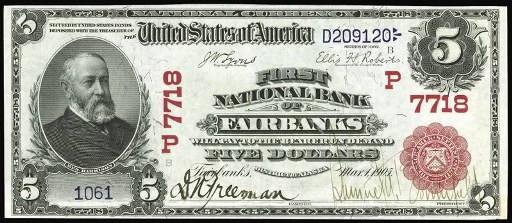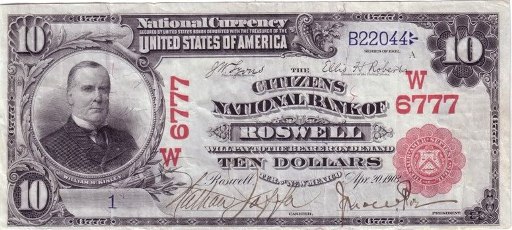The First National Bank Of Minco
The First National Bank Of Minco in Oklahoma printed $136,930 dollars worth of national currency. That is a small output. National bank notes from here should be scarce. This national bank opened in 1907 and stopped printing money in 1935, which equals a 29 year printing period. That is a fairly normal lifespan for a national bank. During its life, The First National Bank Of Minco issued 6 different types and denominations of national currency. We have examples of the types listed below. Your bank note should look similar. Just the bank name will be different. For the record, The First National Bank Of Minco was located in Grady County. It was assigned charter number 8644.
We buy all national currency. Please call or email us for a quote. Sales@AntiqueMoney.com
The First National Bank Of Minco in Oklahoma issued 200 sheets of $5 1902 territorial red seal national bank notes. That is a remarkably small number. Any note known to exist from a print run like that would be a true statistical miracle of survival. 1902 red seals have always been a collector favorite. Territorial bank notes have always been popular. When you combine those two factors the result can be a very valuable bank note. We are of course specifically looking at the five dollar denomination. Most $5 red seals are known to exist from Fairbanks, Alaska, thanks to a hoard discovery in the 1960s. There are also about a dozen $5 territorial red seals known to exist from Oklahoma. The design is exactly like any other third charter bank note. Ben Harrison is on the left hand side of the bill. There is a red four digit charter number and red seal. The charter number is printed around the border of the bill several times.
1902 $5 Red Seal Territorial National Bank Note
The First National Bank Of Minco printed 200 sheets of $10 1902 territorial red seal national bank notes. That is a remarkably small number. Any note known to exist from a print run like that would be a true statistical miracle of survival. This denomination and type was the most prolifically issued territorial note. Some can be quite rare. There is a hierarchy in terms of rarity. Red seals from Hawaii are the absolute rarest. In fact, none from Hawaii are currently known to exist. Ten dollar red seals from Porto Rico are also extremely rare, as are red seals from Alaska. The average collector is most likely to encounter red seals from Arizona, New Mexico, and Oklahoma. There were far more territorial banks in Oklahoma during the red seal period than any other state, so notes from Oklahoma are the most common. However, most all red seals should be worth more than $10,000, and sometimes considerably more. William McKinley is pictured on the left hand side of each bill. The number under McKinley is the bank serial number. If that number is #1, then you can expect an additional premium on the value.
1902 $10 Red Seal Territorial National Bank Note
The First National Bank Of Minco also printed 1,857 sheets of $5 1902 blue seal national bank notes. Most banks that printed such a small number of blue seal bank notes fall into the rare bank category. Ben Harrison is on the front of all 1902 $5 blue seal bank notes. This happens to be the smallest denomination issued for the 1902 series. Each note is complete with a blue seal and blue charter number. Despite saying series of 1902, these were actually issued by national banks between 1908 and 1928. There are two different types of blue seals. The first type is called a date back and it has “1902-1908” written on the back of the bill. The other type is called a plain back; it does not have the date stamps on the back of the bill. The values for these notes range widely based on condition and the bank of issue.
1902 $5 Blue Seal National Bank Note
The First National Bank Of Minco also printed 1,426 sheets of $10 1902 blue seal national bank notes. Most banks that printed such a small number of blue seal bank notes fall into the rare bank category. 1902 $10 blue seal bank notes all have a portrait of William McKinley on them. Values can range from as little as $40 up to over $10,000. There really is no trick to know what is rare and what is common by just doing an internet search. You really need to work with an expert (like us) in order to determine the value of your specific bank note. There are at least ten different factors than can make some 1902 $10 blue seals worth more than others. We know exactly what to look for and we would be happy to provide a free appraisal and our best offer.
1902 $10 Blue Seal National Bank Note
The First National Bank Of Minco also printed 501 sheets of Type1 1929 $5 national bank notes. This is a small print range, but it does not guarantee rarity. Every 1929 $5 bill has a portrait of Abraham Lincoln on it. This is also the lowest denomination of small size national currency that any bank issued. All serial numbers end with the letter A and start with a letter between A and F. Remember that you can take the total number of sheets printed and multiply it by six get to the actual number of bank notes printed for this denomination. All small size national bank notes were printed on sheets of six.
Series of 1929 Type1 $5 National Bank Note
The First National Bank Of Minco also printed 262 sheets of Type1 1929 $10 national bank notes. That may sound like a very small number, and it is. However, when it comes to small size notes, that print range usually allows for a handful of survivors. Each $10 bill from 1929 has a portrait of Alexander Hamilton on it. The black number written vertically is the charter number. The charter number never affects the value; it is just an identifier. The ten dollar type1 national bank note happens to be the single most common national bank note, with over 65,000 known to exist from all banks. Of course each note is valued based on its condition and rarity. Some are very rare.
Series of 1929 Type1 $10 National Bank Note



